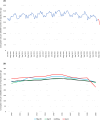Impact of the COVID-19 pandemic on pregnancy complications and conceptions resulting in births following spontaneous conception and in-vitro fertilization in British Columbia: A population-based study
- PMID: 40768520
- PMCID: PMC12327596
- DOI: 10.1371/journal.pone.0329683
Impact of the COVID-19 pandemic on pregnancy complications and conceptions resulting in births following spontaneous conception and in-vitro fertilization in British Columbia: A population-based study
Abstract
Objectives: To investigate the impact of the COVID-19 pandemic's onset on clinical and demographic characteristics, pregnancy complications, and monthly conception rates resulting in births through spontaneous conceptions and in-vitro fertilization (IVF) in British Columbia (BC), Canada.
Materials and methods: This retrospective population-based cohort study examined individuals who gave birth (both live births and stillbirths) in BC between June 1, 2010, and March 31, 2021, with estimated conception dates from January 1, 2010 to June 30, 2020. Data were obtained from the BC Perinatal Data Registry. Two groups were identified based on the estimated conception date: the pre-pandemic conception group (conception from January-1-2010 to February-29-2020) and the pandemic conception group (conception from March-1-2020 to June-30-2020). A time series forecasting method (ARIMA) was employed to observe trends in conception rates during the study period.
Results: 304,244 individuals with pregnancies resulting in live births or stillbirths during the study period were evaluated. A total of 429,843 such conceptions were included in the study: 417,753 (97.2%) occurring before the onset of the pandemic and 12,090 (2.8%) in the pandemic period. In June 2020, conceptions resulting in births decreased by 26.6% compared with June 2019. Trends in conceptions resulting in live births were similar, with a conception rate of 235.2 per 100,000 women of reproductive age in June 2020, compared with the expected rate of 305.0 per 100,000. In March 2020, 0.5% of conceptions that resulted in births ended in stillbirths, compared to 1.7% in March 2019. IVF conceptions ending in births declined during the pandemic, dropping to 2.5 and 2.8 per 100,000 in March and April 2020, respectively, compared with the expected 13.1 per 100,000. However, by June 2020, these rates began to recover toward the expected levels. Rates of gestational diabetes mellites (GDM), gestational hypertension (GHTN), and postpartum intensive care unit (ICU) admissions were similar before and during the COVID-19 pandemic.
Conclusions: During the challenging period of the COVID-19 pandemic in BC, couples may have chosen to delay conception. Rates of conceptions resulting in stillbirths remained relatively unchanged. IVF conception rates were impacted by the suspension of elective procedures. Preterm birth rates slightly exceeded expected levels but remained within normal fluctuations, and small increases in GDM and GHTN prevalence were also observed.
Copyright: © 2025 Eckler et al. This is an open access article distributed under the terms of the Creative Commons Attribution License, which permits unrestricted use, distribution, and reproduction in any medium, provided the original author and source are credited.
Conflict of interest statement
P.J.Y: Research grants from Canadian Institutes of Health Research (CIHR) and a Michael Smith Foundation for Health Research Grant. - M.A.B: Research grants from Canadian Institutes of Health Research (CIHR) and Ferring Pharmaceutical. He is on the advisory board for AbbVie, Pfizer, and Baxter. - Other authors do not have any declarations of interest. These competing interests do not alter our adherence to PLOS ONE policies on sharing data and materials.
Figures




Similar articles
-
COVID-19 and Recurrent Pregnancy Loss Management: Trends in Clinical Care From a Tertiary Centre.J Obstet Gynaecol Can. 2025 May;47(5):102817. doi: 10.1016/j.jogc.2025.102817. Epub 2025 Mar 14. J Obstet Gynaecol Can. 2025. PMID: 40090485
-
Effect of the COVID-19 Pandemic on Stillbirths in Canada and the United States.J Obstet Gynaecol Can. 2024 Apr;46(4):102338. doi: 10.1016/j.jogc.2023.102338. Epub 2023 Dec 30. J Obstet Gynaecol Can. 2024. PMID: 38160796
-
Application of seminal plasma to female genital tract prior to embryo transfer in assisted reproductive technology cycles (IVF, ICSI and frozen embryo transfer).Cochrane Database Syst Rev. 2018 Feb 28;2(2):CD011809. doi: 10.1002/14651858.CD011809.pub2. Cochrane Database Syst Rev. 2018. PMID: 29489026 Free PMC article.
-
Antioxidants for male subfertility.Cochrane Database Syst Rev. 2014;(12):CD007411. doi: 10.1002/14651858.CD007411.pub3. Epub 2014 Dec 15. Cochrane Database Syst Rev. 2014. Update in: Cochrane Database Syst Rev. 2019 Mar 14;3:CD007411. doi: 10.1002/14651858.CD007411.pub4. PMID: 25504418 Updated.
-
Individualised gonadotropin dose selection using markers of ovarian reserve for women undergoing in vitro fertilisation plus intracytoplasmic sperm injection (IVF/ICSI).Cochrane Database Syst Rev. 2018 Feb 1;2(2):CD012693. doi: 10.1002/14651858.CD012693.pub2. Cochrane Database Syst Rev. 2018. Update in: Cochrane Database Syst Rev. 2024 Jan 4;1:CD012693. doi: 10.1002/14651858.CD012693.pub3. PMID: 29388198 Free PMC article. Updated.
References
-
- World Health Organization. WHO Director-General’s remarks at the media briefing on 2019-nCoV on 11 February 2020. 2020 Feb 11 [cited April 1, 2024]. Available from: https://www.who.int/director-general/speeches/detail/who-director-genera...
-
- ESHRE-European Society of Human Reproduction and Embryology. ESHRE COVID-19 Working Group. ESHRE; 2020. [cited June 1, 2024]. Available from: https://www.eshre.eu/Home/COVID19WG
MeSH terms
LinkOut - more resources
Full Text Sources
Medical
Miscellaneous

